On the WEDM of WNbMoTaZrx (x = 0.5, 1) Refractory High Entropy Alloys
Abstract
:1. Introduction
2. Materials and Methods
2.1. Workpiece Materials
2.2. WEDM Processing
3. Results and Discussion
3.1. WEDM Results, Based on the Orthogonal Experiments
3.1.1. Cutting Efficiency (CE)
3.1.2. Surface Roughness (Ra)
3.2. Comparison of the WEDM Performance
3.2.1. Cutting Efficiency (CE)
3.2.2. Surface Roughness (Ra)
3.3. Microstructure and the Element Variation of the WEDMed Surfaces of RHEAs
3.4. WEDM Results of the RHEAs, Based on the Single-Factor Experiments
3.4.1. Cutting Efficiency (CE)
3.4.2. Surface Roughness (Ra)
4. Conclusions
Author Contributions
Funding
Institutional Review Board Statement
Data Availability Statement
Conflicts of Interest
Appendix A
| Material | Parameters | DF | Adjusted | Contribution (%) | Adjusted MS | F-Value | Rank |
|---|---|---|---|---|---|---|---|
| Zr0.5 | ON | 2 | 21.360 | 9.65 | 10.680 | 12.96 | 3 |
| OFF | 2 | 16.398 | 7.41 | 8.199 | 9.95 | 4 | |
| IP | 2 | 31.017 | 14.02 | 15.509 | 18.82 | 2 | |
| SV | 2 | 1.135 | 0.52 | 0.567 | 0.69 | 6 | |
| GP | 2 | 143.134 | 64.69 | 71.567 | 86.87 | 1 | |
| WS | 2 | 4.091 | 1.85 | 2.046 | 2.48 | 5 | |
| Error | 5 | 4.119 | 1.86 | 0.824 | - | - | |
| Total | 17 | 221.254 | 100.00 | - | - | - | |
| Zr1.0 | ON | 2 | 38.652 | 11.76 | 19.326 | 13.26 | 3 |
| OFF | 2 | 20.133 | 6.12 | 10.066 | 6.91 | 4 | |
| IP | 2 | 44.764 | 13.62 | 22.382 | 15.36 | 2 | |
| SV | 2 | 3.490 | 1.06 | 1.745 | 1.20 | 6 | |
| GP | 2 | 209.106 | 63.61 | 104.553 | 71.76 | 1 | |
| WS | 2 | 5.283 | 1.61 | 2.641 | 1.81 | 5 | |
| Error | 5 | 7.285 | 2.22 | 1.457 | - | - | |
| Total | 17 | 328.713 | 100.00 | - | - | - | |
| Zr702 | ON | 2 | 122.882 | 17.06 | 61.441 | 32.59 | 2 |
| OFF | 2 | 56.531 | 7.85 | 28.266 | 14.99 | 4 | |
| IP | 2 | 64.639 | 8.97 | 32.320 | 17.14 | 3 | |
| SV | 2 | 6.174 | 0.86 | 3.087 | 1.64 | 6 | |
| GP | 2 | 438.961 | 60.93 | 219.481 | 116.42 | 1 | |
| WS | 2 | 21.772 | 3.02 | 10.886 | 5.77 | 5 | |
| Error | 5 | 9.426 | 1.31 | 1.885 | - | - | |
| Total | 17 | 720.385 | 100.00 | - | - | - | |
| Tungsten | ON | 2 | 4.636 | 11.24 | 2.318 | 13.75 | 3 |
| OFF | 2 | 0.882 | 2.14 | 0.441 | 2.62 | 4 | |
| IP | 2 | 7.186 | 17.43 | 3.593 | 21.31 | 2 | |
| SV | 2 | 0.388 | 0.94 | 0.194 | 1.15 | 6 | |
| GP | 2 | 26.438 | 64.11 | 13.219 | 78.41 | 1 | |
| WS | 2 | 0.865 | 2.10 | 0.432 | 2.56 | 5 | |
| Error | 5 | 0.843 | 2.04 | 0.169 | - | - | |
| Total | 17 | 41.238 | 100.00 | - | - | - | |
| YG8 | ON | 2 | 37.167 | 11.28 | 18.584 | 31.56 | 2 |
| OFF | 2 | 36.581 | 11.11 | 18.290 | 31.07 | 3 | |
| IP | 2 | 27.043 | 8.21 | 13.522 | 22.97 | 4 | |
| SV | 2 | 4.247 | 1.29 | 2.123 | 3.61 | 6 | |
| GP | 2 | 214.828 | 65.22 | 107.414 | 182.44 | 1 | |
| WS | 2 | 6.583 | 2.00 | 3.291 | 5.59 | 5 | |
| Error | 5 | 2.944 | 0.89 | 0.589 | - | - | |
| Total | 17 | 329.393 | 100.00 | - | - | - |
| Material | Parameters | DF | Adjusted | Contribution (%) | Adjusted MS | F-Value | Rank |
|---|---|---|---|---|---|---|---|
| Zr0.5 | ON | 2 | 2.207 | 15.25 | 1.103 | 1.74 | 2 |
| OFF | 2 | 0.529 | 3.65 | 0.264 | 0.42 | 5 | |
| IP | 2 | 4.450 | 30.76 | 2.225 | 3.51 | 1 | |
| SV | 2 | 1.988 | 13.75 | 0.994 | 1.57 | 3 | |
| GP | 2 | 0.441 | 3.05 | 0.220 | 0.35 | 6 | |
| WS | 2 | 1.687 | 11.66 | 0.843 | 1.33 | 4 | |
| Error | 5 | 3.166 | 21.88 | 0.633 | - | - | |
| Total | 17 | 14.468 | 100.00 | - | - | - | |
| Zr1.0 | ON | 2 | 5.619 | 36.63 | 2.809 | 5.88 | 1 |
| OFF | 2 | 1.489 | 9.71 | 1.245 | 2.60 | 2 | |
| IP | 2 | 1.902 | 12.40 | 0.951 | 1.99 | 3 | |
| SV | 2 | 1.801 | 11.74 | 0.900 | 1.88 | 4 | |
| GP | 2 | 1.755 | 11.44 | 0.877 | 1.84 | 5 | |
| WS | 2 | 0.383 | 2.49 | 0.191 | 0.40 | 6 | |
| Error | 5 | 2.390 | 15.59 | 0.478 | - | - | |
| Total | 17 | 15.339 | 100.00 | - | - | - | |
| Zr702 | ON | 2 | 8.956 | 67.63 | 4.478 | 21.05 | 1 |
| OFF | 2 | 0.054 | 0.41 | 0.027 | 0.13 | 6 | |
| IP | 2 | 0.534 | 4.04 | 0.267 | 1.26 | 4 | |
| SV | 2 | 1.508 | 11.39 | 0.754 | 3.54 | 2 | |
| GP | 2 | 0.984 | 7.43 | 0.492 | 2.31 | 3 | |
| WS | 2 | 0.143 | 1.08 | 0.072 | 0.34 | 5 | |
| Error | 5 | 1.064 | 8.02 | 0.213 | - | - | |
| Total | 17 | 13.243 | 100.00 | - | - | - | |
| Tungsten | ON | 2 | 1.006 | 27.14 | 0.503 | 5.00 | 2 |
| OFF | 2 | 0.003 | 0.07 | 0.001 | 0.01 | 6 | |
| IP | 2 | 2.042 | 55.05 | 1.021 | 10.14 | 1 | |
| SV | 2 | 0.098 | 2.63 | 0.049 | 0.48 | 3 | |
| GP | 2 | 0.017 | 0.45 | 0.008 | 0.08 | 5 | |
| WS | 2 | 0.040 | 1.09 | 0.020 | 0.20 | 4 | |
| Error | 5 | 0.503 | 13.57 | 0.101 | - | - | |
| Total | 17 | 3.709 | 100.00 | - | - | - | |
| YG8 | ON | 2 | 3.568 | 41.62 | 1.782 | 27.38 | 1 |
| OFF | 2 | 0.460 | 5.37 | 0.230 | 3.53 | 5 | |
| IP | 2 | 1.487 | 17.34 | 0.743 | 11.41 | 3 | |
| SV | 2 | 1.731 | 20.19 | 0.865 | 13.28 | 2 | |
| GP | 2 | 0.748 | 8.72 | 0.374 | 5.74 | 4 | |
| WS | 2 | 0.254 | 2.96 | 0.127 | 1.95 | 6 | |
| Error | 5 | 0.326 | 3.80 | 0.065 | - | - | |
| Total | 17 | 8.574 | 100.00 | - | - | - |
References
- Cantor, B.; Chang, I.T.H.; Knight, P.; Vincent, A.J.B. Microstructural development in equiatomic multicomponent alloys. Mater. Sci. Eng. A 2004, 375–377, 213–218. [Google Scholar] [CrossRef]
- EI-Atwani, O.; Li, N.; Li, M.; Devaraj, A.; Baldwin, J.K.S.; Schneider, M.M.; Sobieraj, D.; Wróbel, J.S.; Nguyen-Manh, D.; Maloy, S.A.; et al. Outstanding radiation resistance of tungsten-based high-entropy alloys. Sci. Adv. 2019, 5, eaav2002. [Google Scholar] [CrossRef] [PubMed] [Green Version]
- Tsai, M.H.; Yeh, J.W. High-Entropy Alloys: A Critical Review. Mater. Res. Lett. 2014, 2, 107–123. [Google Scholar] [CrossRef]
- Yeh, J.W.; Chen, S.K.; Lin, S.J.; Gan, J.Y.; Chin, T.S.; Shun, T.T.; Tsau, C.H.; Chang, S.Y. Nanostructured high-entropy alloys with multiple principal elements novel alloy design concepts and outcomes. Adv. Eng. Mater. 2004, 6, 299–303. [Google Scholar] [CrossRef]
- George, E.P.; Raabe, D.; Ritchie, R.O. High-entropy alloys. Nat. Rev. Mater. 2019, 4, 515–534. [Google Scholar] [CrossRef]
- Zhang, Y.; Zuo, T.T.; Tang, Z.; Gao, M.C.; Dahmen, K.A.; Liaw, P.K.; Lu, Z.P. Microstructures and properties of high-entropy alloys. Prog. Mater. Sci. 2014, 61, 1–93. [Google Scholar] [CrossRef]
- Miracle, D.B.; Senkov, O.N. A critical review of high entropy alloys and related concepts. Acta Mater. 2017, 122, 448–511. [Google Scholar] [CrossRef] [Green Version]
- Senkov, O.N.; Wilks, G.B.; Miracle, D.B.; Chuang, C.P.; Liaw, P.K. Refractory high-entropy alloys. Intermetallics 2010, 18, 1758–1765. [Google Scholar] [CrossRef]
- Senkov, O.N.; Wilks, G.B.; Scott, J.M.; Miracle, D.B. Mechanical properties of Nb25Mo25Ta25W25 and V20Nb20Mo20Ta20W20 refractory high entropy alloys. Intermetallics 2011, 19, 698–706. [Google Scholar] [CrossRef]
- Chen, J.; Zhou, X.Y.; Wang, W.L.; Liu, B.; Lv, Y.K.; Yang, W.; Xu, D.P.; Liu, Y. A review on fundamental of high entropy alloys with promising high–temperature properties. J. Alloys. Compd. 2018, 760, 15–30. [Google Scholar] [CrossRef]
- Senkov, O.N.; Miracle, D.B.; Chaput, K.J.; Couzinie, J.P. Development and exploration of refractory high entropy alloys—A review. J. Mater. Res. 2018, 33, 3092–3128. [Google Scholar] [CrossRef] [Green Version]
- Li, C.; Chen, S.H.; Wu, Z.W.; Zhang, Z.F.; Wu, Y.C. Development of high-strength WNbMoTaVZrx refractory high entropy alloys. J. Mater. Res. 2022, 37, 1664–1678. [Google Scholar] [CrossRef]
- Senkov, O.N.; Senkova, S.V.; Woodward, C.; Miracle, D.B. Low-density, refractory multi-principal element alloys of the Cr–Nb–Ti–V–Zr system: Microstructure and phase analysis. Acta Mater. 2013, 61, 1545–1557. [Google Scholar] [CrossRef]
- Stepanov, N.D.; Shaysultanov, D.G.; Salishchev, G.A.; Tikhonovsky, M.A. Structure and mechanical properties of a light-weight AlNbTiV high entropy alloy. Mater. Lett. 2015, 142, 153–155. [Google Scholar] [CrossRef]
- Zhang, J.S.; Chen, S.H.; Liu, J.Q.; Qing, Z.H.; Wu, Y.C. Microstructure and Mechanical Properties of Novel High-Strength, Low-Activation Wx(TaVZr)100−x (x = 5, 10, 15, 20, 25) Refractory High Entropy Alloys. Entropy 2022, 24, 1342. [Google Scholar] [CrossRef]
- Chen, S.H.; Qi, C.; Liu, J.Q.; Zhang, J.S.; Wu, Y.C. Recent Advances in W-Containing Refractory High-Entropy Alloys—An Overview. Entropy 2022, 24, 1553. [Google Scholar] [CrossRef]
- Davim, J.P.; Maranhão, C.; Cabral, G.; Grácio, J. Performance of cutting tools in machining Cu/W alloys for application in EDM electrodes. Int. J. Refract. Met. Hard Mater. 2009, 27, 676–682. [Google Scholar] [CrossRef]
- Pramanik, A. Problems and solutions in machining of titanium alloys. Int. J. Adv. Manuf. Technol. 2013, 70, 919–928. [Google Scholar] [CrossRef]
- Constantin, G.; Balan, E.; Voiculescu, I.; Geanta, V.; Craciun, V. Cutting Behavior of Al0.6CoCrFeNi High Entropy Alloy. Materials 2020, 13, 4181. [Google Scholar] [CrossRef]
- Huang, Z.Y.; Dai, Y.Q.; Li, Z.; Zhang, G.Q.; Chang, C.T.; Ma, J. Investigation on surface morphology and crystalline phase deformation of Al80Li5Mg5Zn5Cu5 high-entropy alloy by ultra-precision cutting. Mater. Des. 2020, 186, 108367. [Google Scholar] [CrossRef]
- Liborius, H.; Uhlig, T.; Clauß, B.; Nestler, A.; Lindner, T.; Schubert, A.; Wagner, G.; Lampke, T. Influence of the cutting material on tool wear, surface roughness, and force components for different cutting speeds in face turning of CoCrFeNi high-entropy alloys. IOP Conf. Ser. Mater. Sci. Eng. 2021, 1147, 012008. [Google Scholar] [CrossRef]
- Zhang, M.; Liu, Z.D.; Pan, H.W.; Deng, C.; Qiu, M.B. Multi-channel discharge characteristics cutting by ultra-fine wire-EDM. Chin. J. Aeronaut. 2022, 35, 308–319. [Google Scholar] [CrossRef]
- Zhang, Y.M.; Zhang, G.J.; Zhang, Z.; Zhang, Y.; Huang, Y. Effect of assisted transverse magnetic field on distortion behavior of thin-walled components in WEDM process. Chin. J. Aeronaut. 2022, 35, 291–307. [Google Scholar] [CrossRef]
- Ho, K.H.; Newman, S.T.; Rahimifard, S.; Allen, R.D. State of the art in wire electrical discharge machining (WEDM). Int. J. Mach. Tools. Manuf. 2004, 44, 1247–1259. [Google Scholar] [CrossRef]
- Shayan, A.V.; Afza, R.A.; Teimouri, R. Parametric study along with selection of optimal solutions in dry wire cut machining of cemented tungsten carbide (WC-Co). J. Manuf. Process. 2013, 15, 644–658. [Google Scholar] [CrossRef]
- Pachaury, Y.; Tandon, P. An overview of electric discharge machining of ceramics and ceramic based composites. J. Manuf. Process. 2017, 25, 369–390. [Google Scholar] [CrossRef]
- Slătineanu, L.; Dodun, O.; Coteaţă, M.; Nagîţ, G.; Băncescu, I.B.; Hriţuc, A. Wire Electrical Discharge Machining—A Review. Machines 2020, 8, 69. [Google Scholar] [CrossRef]
- Chang, W.J.; Li, X.X.; Yang, H.D.; Zhang, J.S.; Zhang, J.C.; Tang, H.H.; Chen, S.H. On the wire EDM of metastable atomic structured bulk metallic glasses. Int. J. Adv. Manuf. Technol. 2022, 120, 5411–5430. [Google Scholar] [CrossRef]
- Ming, W.Y.; Cao, C.; Shen, F.; Zhang, Z.; Liu, K.; Du, J.G.; Jia, H.J. Numerical and experimental study on WEDM of BN-AlN-TiB2 composite ceramics based on a fusion FEM model. J. Manuf. Process. 2022, 76, 138–154. [Google Scholar] [CrossRef]
- Günen, A.; Ceritbinmez, F.; Patel, K.; Akhtar, M.A.; Mukherjee, S.; Kanca, E.; Karakas, M.S. WEDM machining of MoNbTaTiZr refractory high entropy alloy. CIRP J. Manuf. Sci. Technol. 2022, 38, 547–559. [Google Scholar] [CrossRef]
- Ceritbinmez, F.; Günen, A.; Akhtar, M.A.; Patel, K.; Mukherjee, S.; Yünlü, L.; Kanca, E. Surface integrity characteristics in wire-EDM of HfTaTiVZr refractory high entropy alloy. Adv. Mater. Process. Technol. 2022, 1–18. [Google Scholar] [CrossRef]
- Chen, S.H.; Zhang, J.S.; Guan, S.; Li, T.; Liu, J.Q.; Wu, F.F.; Wu, Y.C. Microstructure and mechanical properties of WNbMoTaZrx (x = 0.1, 0.3, 0.5, 1.0) refractory high entropy alloys. Mater. Sci. Eng. A 2022, 835, 142701. [Google Scholar] [CrossRef]
- Sui, M.H.; Li, C.H.; Wu, W.T.; Yang, M.; Ali, H.M.; Zhang, Y.B.; Jia, D.Z.; Hou, Y.L.; Li, R.Z.; Cao, H.J. Temperature of Grinding Carbide With Castor Oil-Based MoS2 Nanofluid Minimum Quantity Lubrication. J. Therm. Sci. Eng. Appl. 2021, 13, 051001. [Google Scholar] [CrossRef]
- Chen, S.H.; Ge, Q.; Zhang, J.S.; Chang, W.J.; Zhang, J.C.; Tang, H.H.; Yang, H.D. Low-speed machining of a Zr-based bulk metallic glass. J. Manuf. Process. 2021, 72, 565–581. [Google Scholar] [CrossRef]
- Hu, L.; Wirth, B.D.; Maroudas, D. Thermal conductivity of tungsten: Effects of plasma-related structural defects from molecular-dynamics simulations. Appl. Phys. Lett. 2017, 111, 081902. [Google Scholar] [CrossRef]
- Huang, H.; Yan, J.W. On the surface characteristics of a Zr-based bulk metallic glass processed by microelectrical discharge machining. Appl. Surf. Sci. 2015, 355, 1306–1315. [Google Scholar] [CrossRef]
- Liao, Y.S.; Yu, Y.P. Study of specific discharge energy in WEDM and its application. Int. J. Mach. Tools. Manuf. 2004, 44, 1373–1380. [Google Scholar] [CrossRef]
- Ming, W.Y.; Zhang, Z.; Wang, S.Y.; Zhang, Y.M.; Shen, F.; Zhang, G.J. Comparative study of energy efficiency and environmental impact in magnetic field assisted and conventional electrical discharge machining. J. Clean. Prod. 2019, 214, 12–28. [Google Scholar] [CrossRef]
- Singh, H. Experimental study of distribution of energy during EDM process for utilization in thermal models. Int. J. Heat Mass Transf. 2012, 55, 5053–5064. [Google Scholar] [CrossRef]
- Ming, W.Y.; Zhang, Z.; Wang, S.Y.; Huang, H.; Zhang, Y.M.; Zhang, Y.; Shen, D.L. Investigating the energy distribution of workpiece and optimizing process parameters during the EDM of Al6061, Inconel718, and SKD11. Int. J. Adv. Manuf. Technol. 2017, 92, 4039–4056. [Google Scholar] [CrossRef]
- Rahman, S.S.; Ashraf, M.Z.I.; Bashar, M.S.; Kamruzzaman, M.; Nurul Amin, A.K.M.; Hossain, M.M. Crystallinity, surface morphology, and chemical composition of the recast layer and rutile-TiO2 formation on Ti-6Al-4V ELI by wire-EDM to enhance biocompatibility. Int. J. Adv. Manuf. Technol. 2017, 93, 3285–3296. [Google Scholar] [CrossRef]
- Huang, C.A.; Hsu, C.C.; Kuo, H.H. The surface characteristics of P/M high-speed steel (ASP 23) multi-cut with wire electrical discharge machine (WEDM). J. Mater. Process. Technol. 2003, 140, 298–302. [Google Scholar] [CrossRef]
- Kumar, S.; Grover, S.; Walia, R.S. Effect of hybrid wire EDM conditions on generation of residual stresses in machining of HCHCr D2 tool steel under ultrasonic vibration. Int. J. Interact. Des. Manuf. 2018, 12, 1119–1137. [Google Scholar] [CrossRef]
- Mishra, V.; Pandey, P.M. Experimental investigations into electric discharge grinding and ultrasonic vibration-assisted electric discharge grinding of Inconel 601. Mater. Manuf. Process. 2018, 33, 1518–1530. [Google Scholar] [CrossRef]
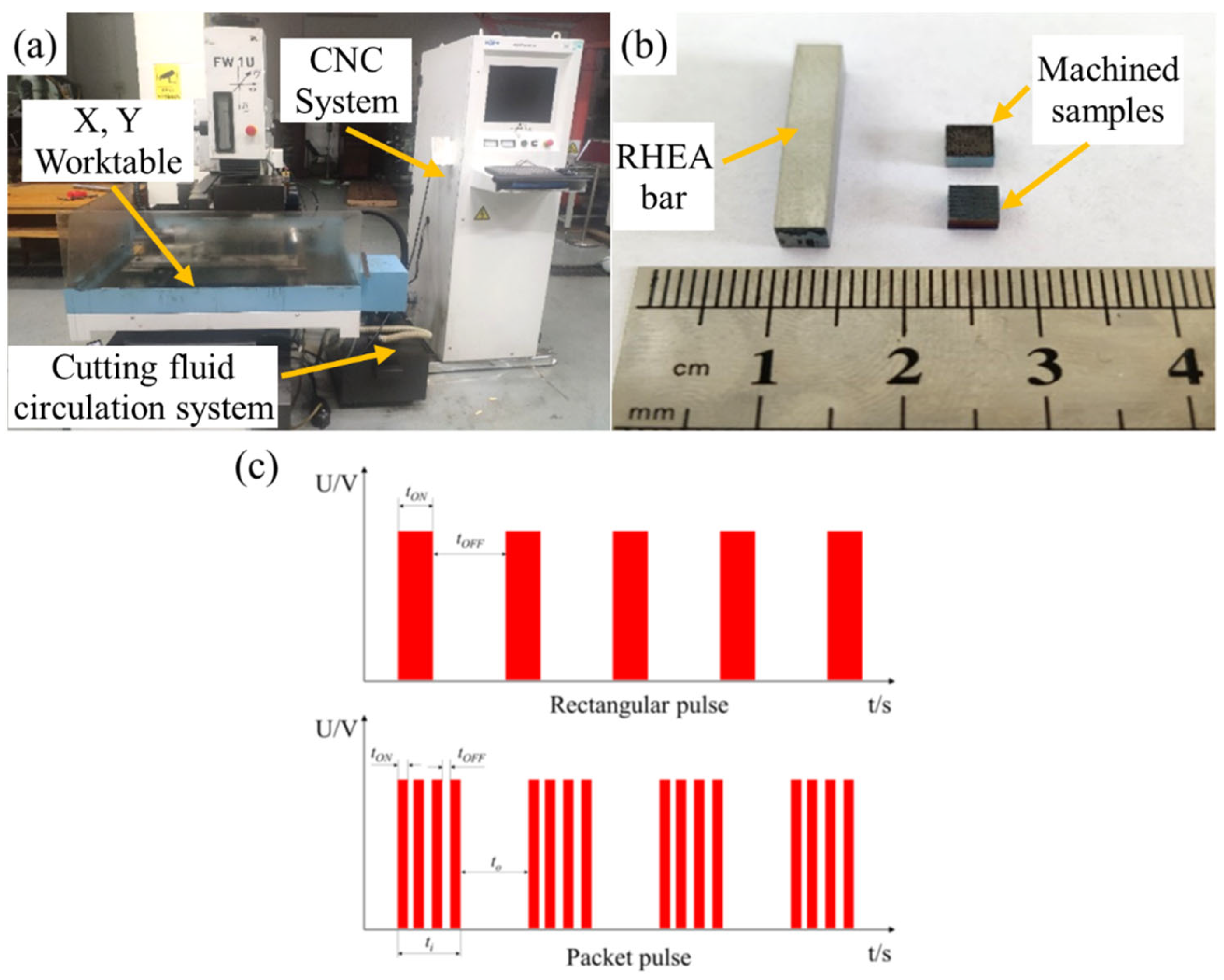

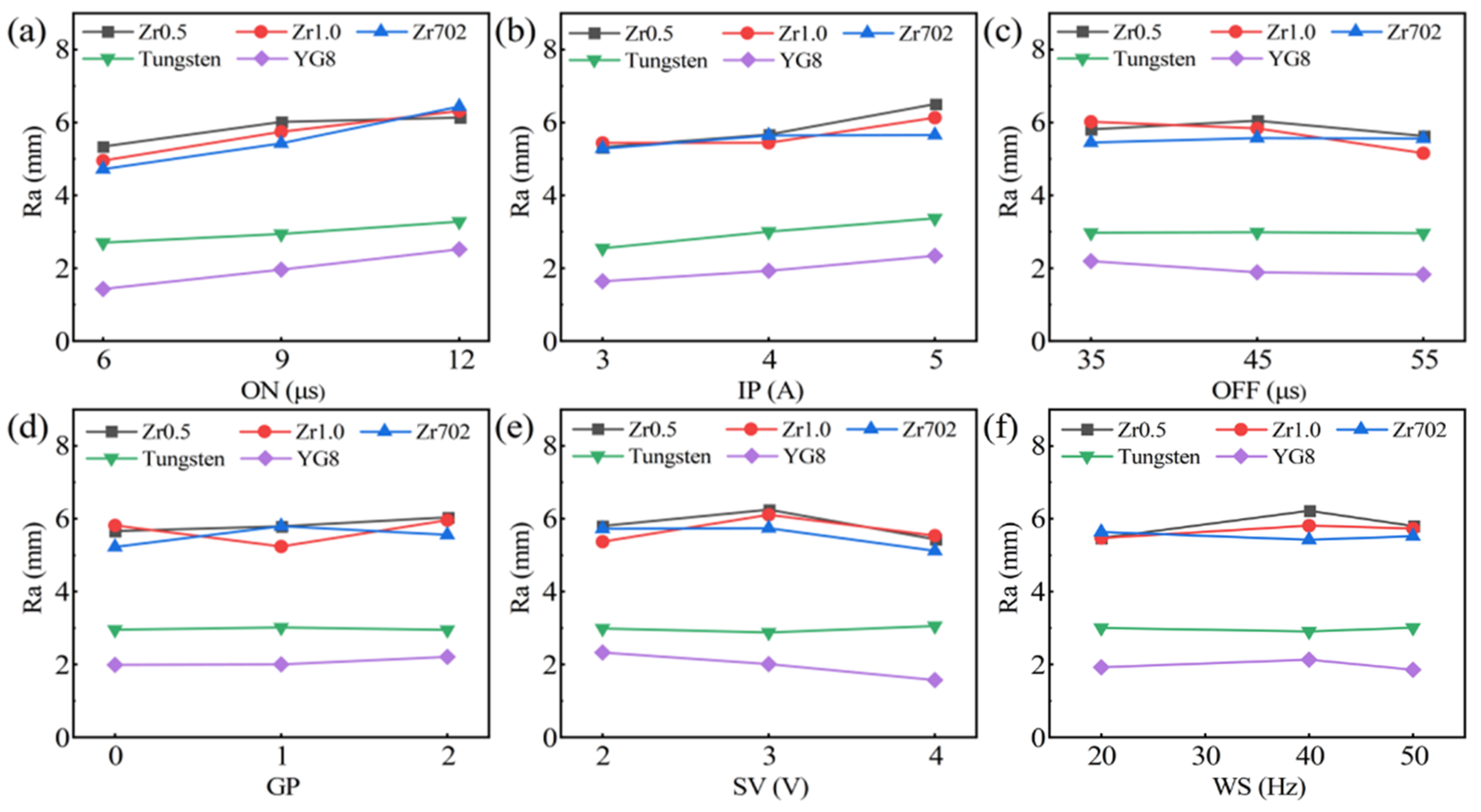

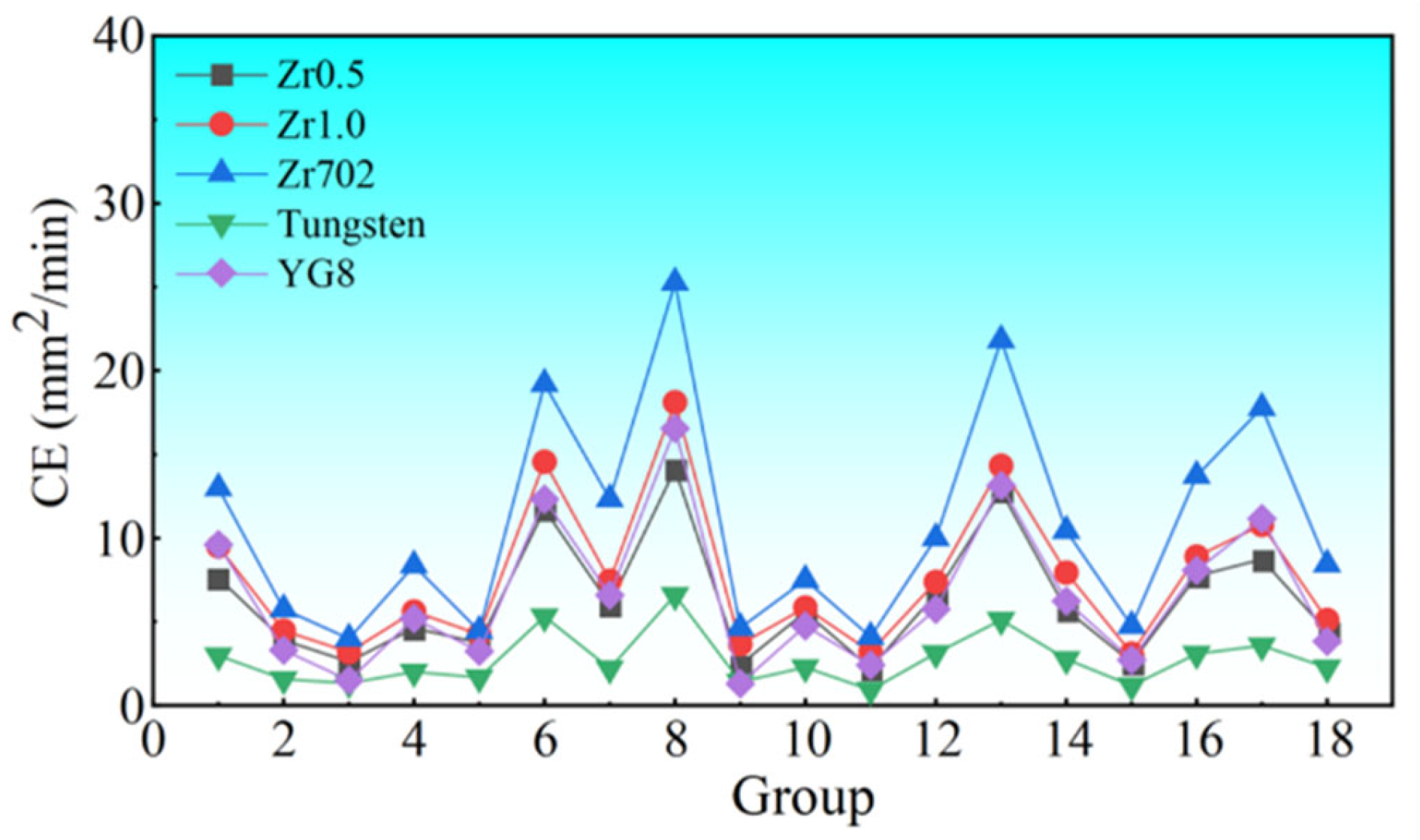
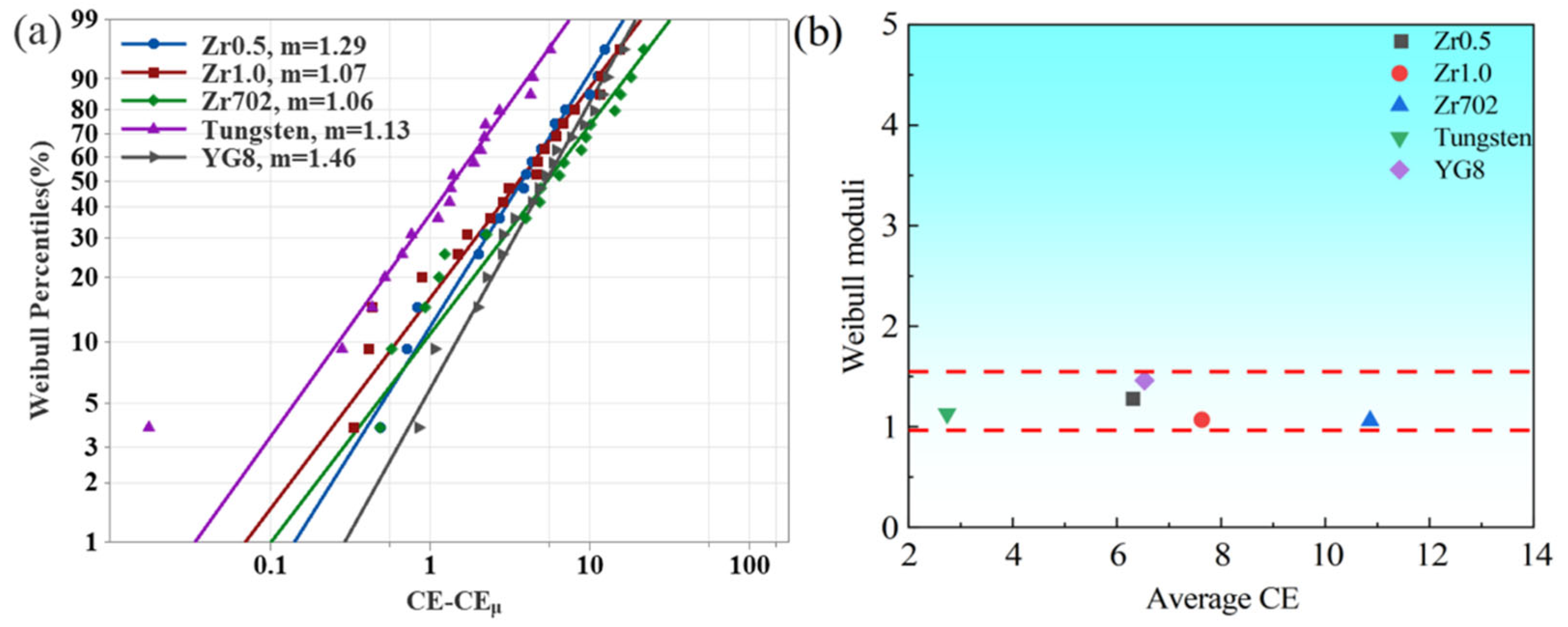
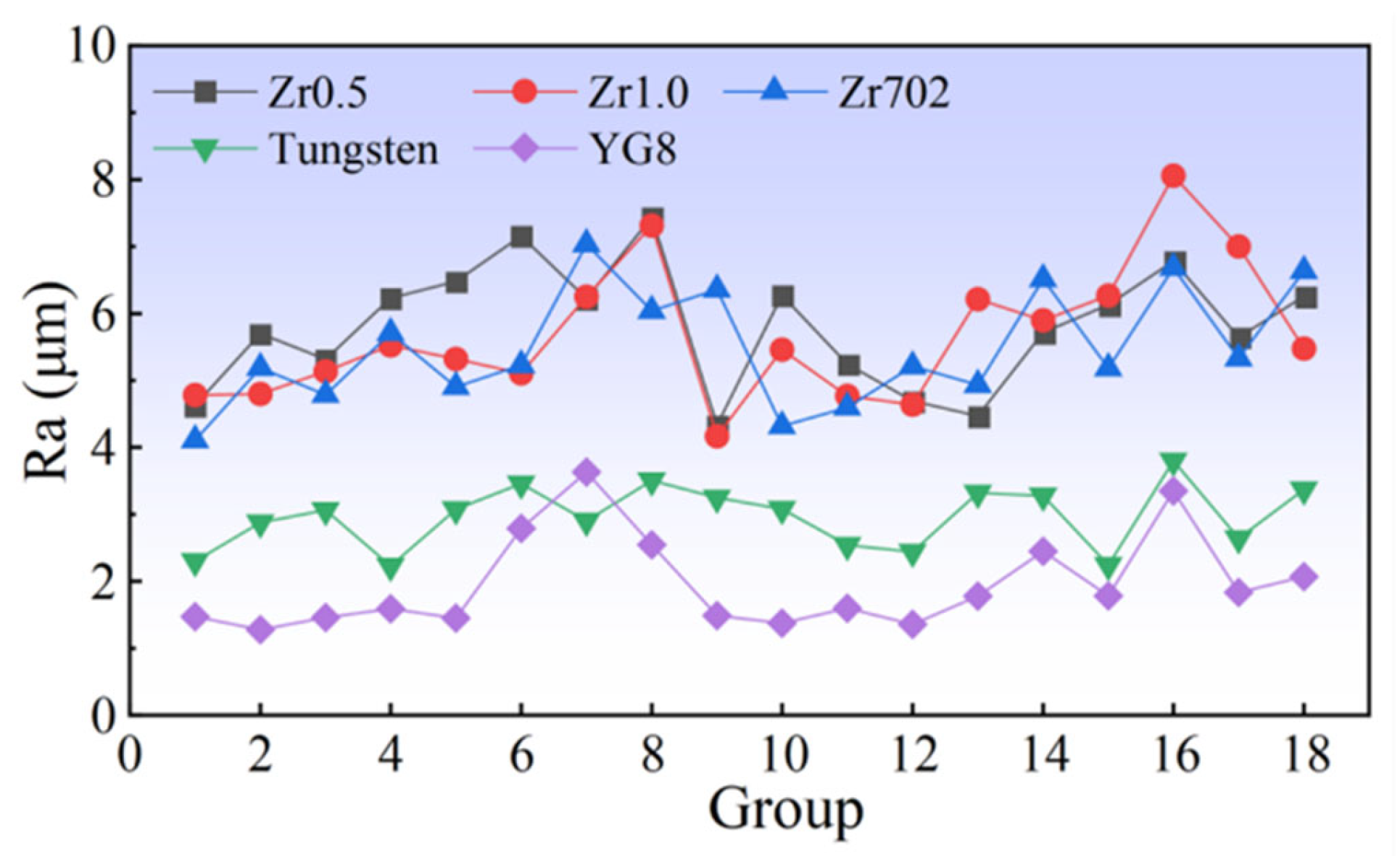
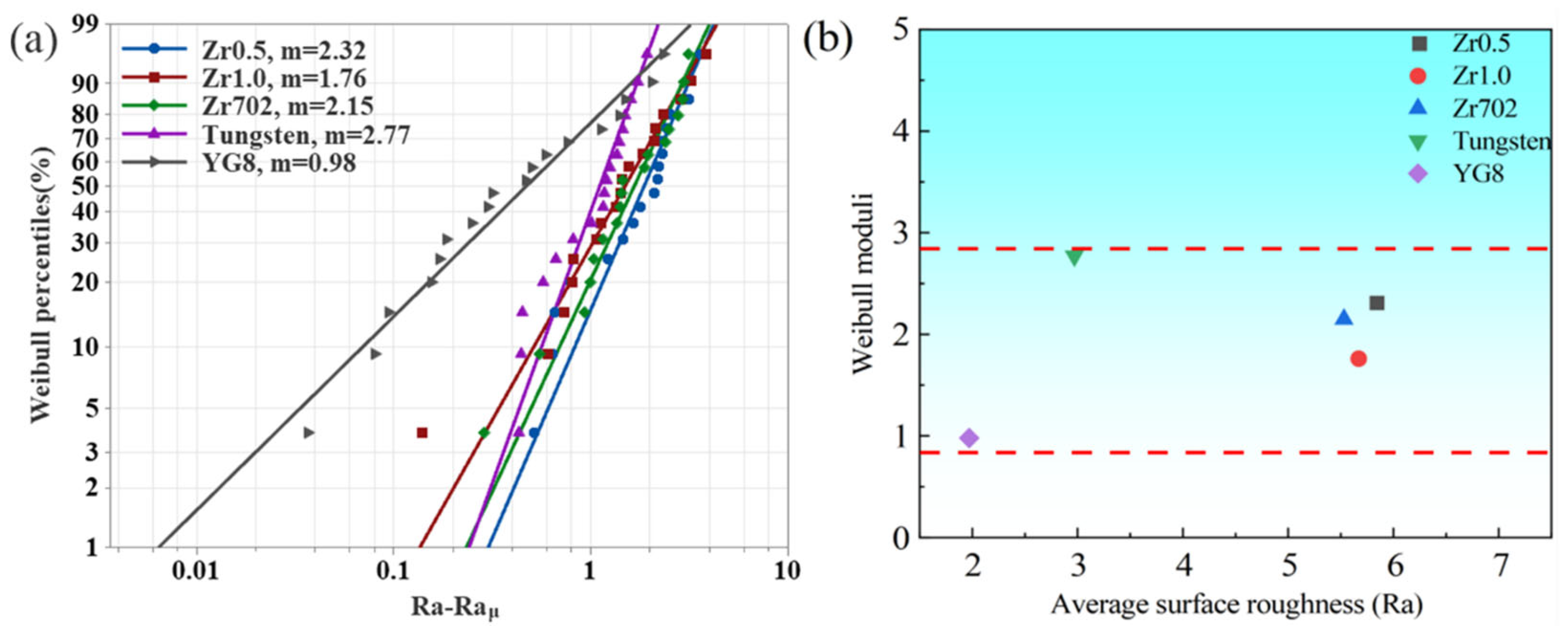
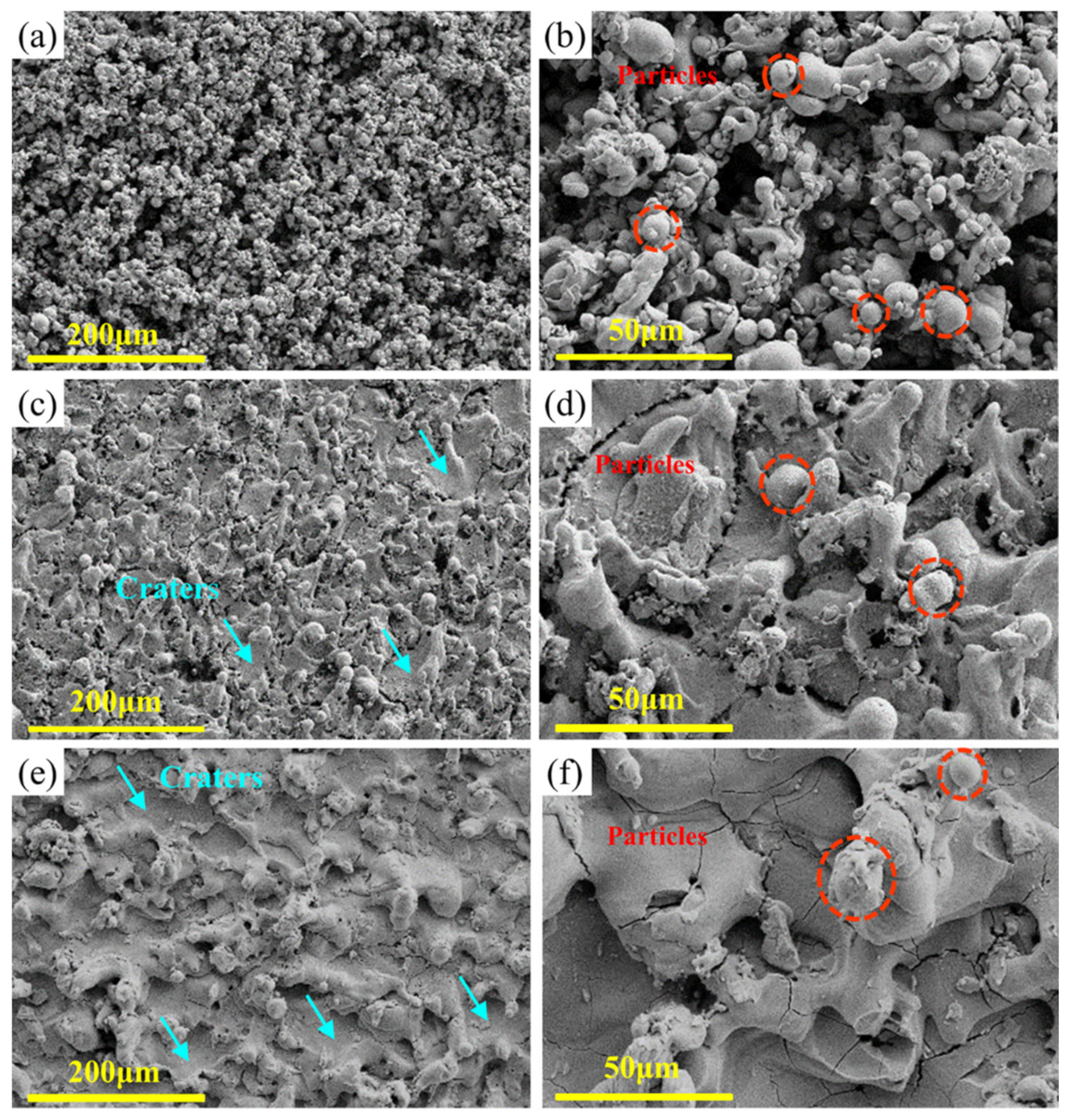
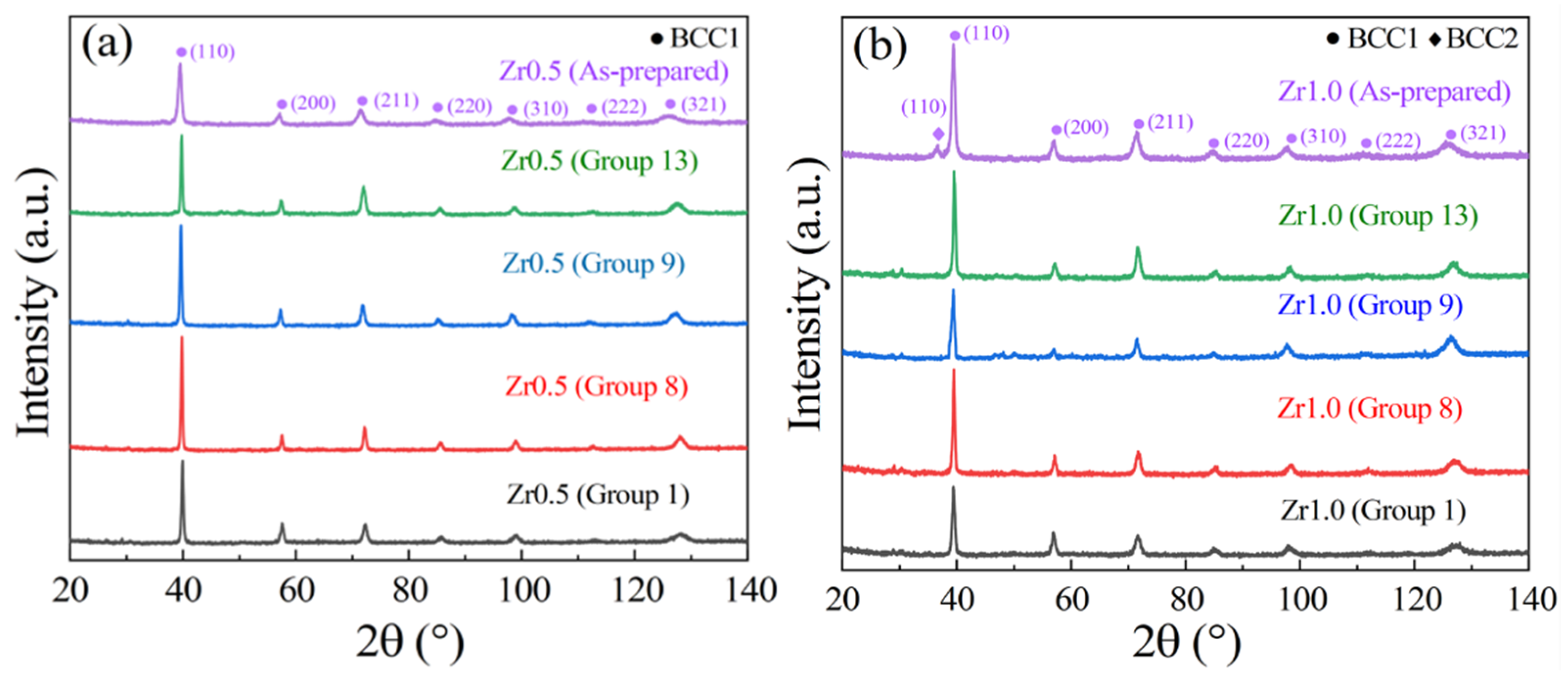
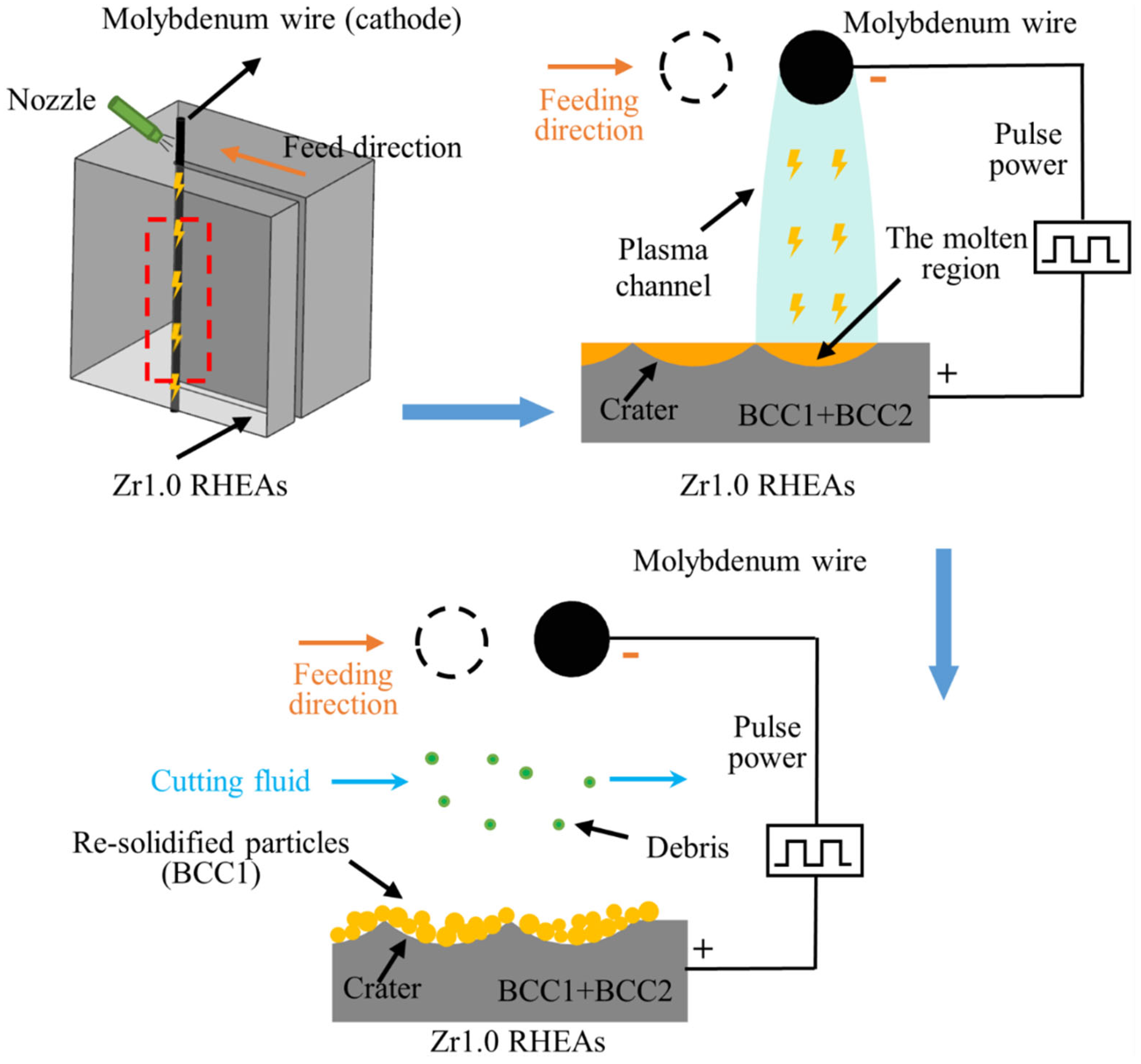
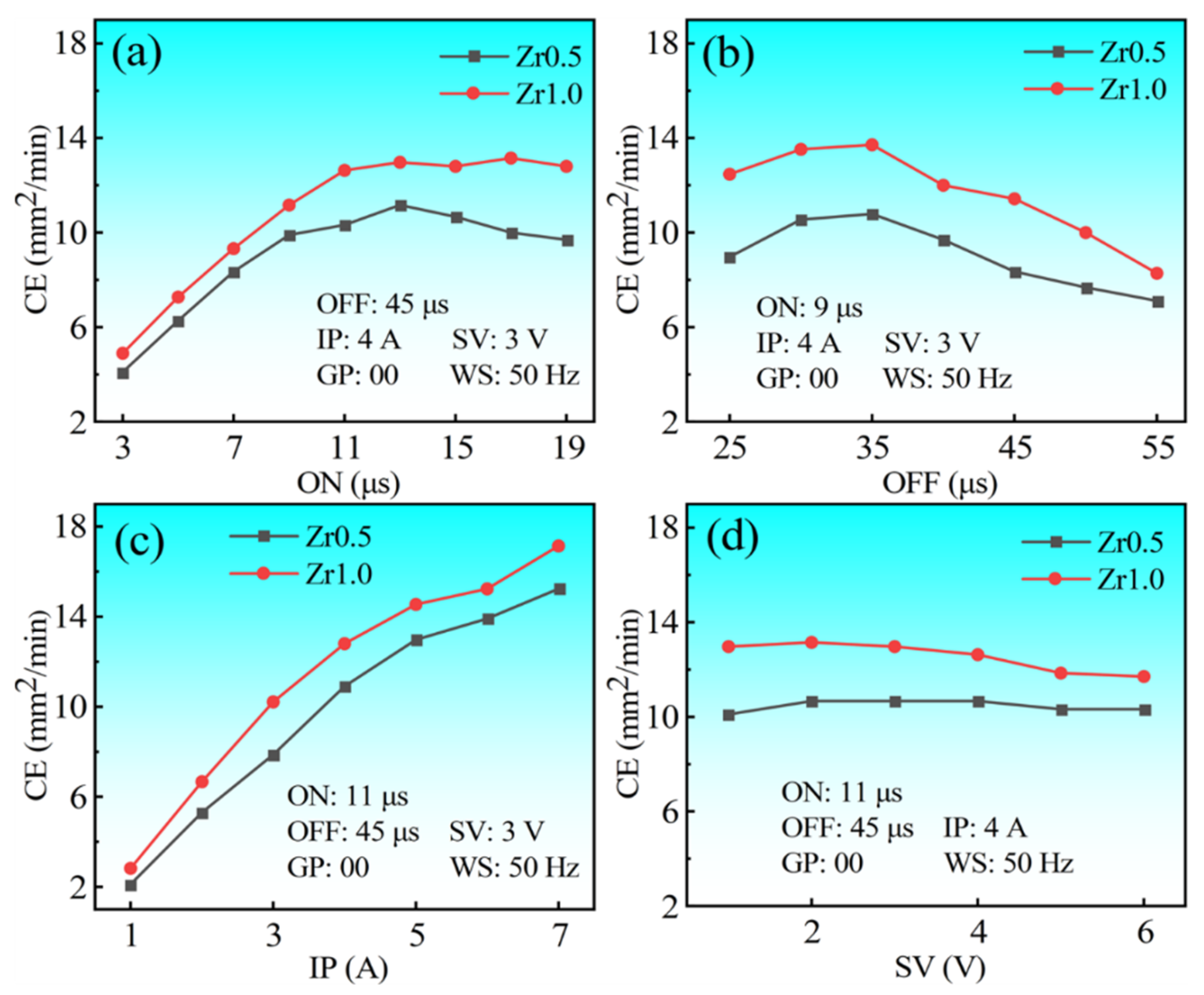
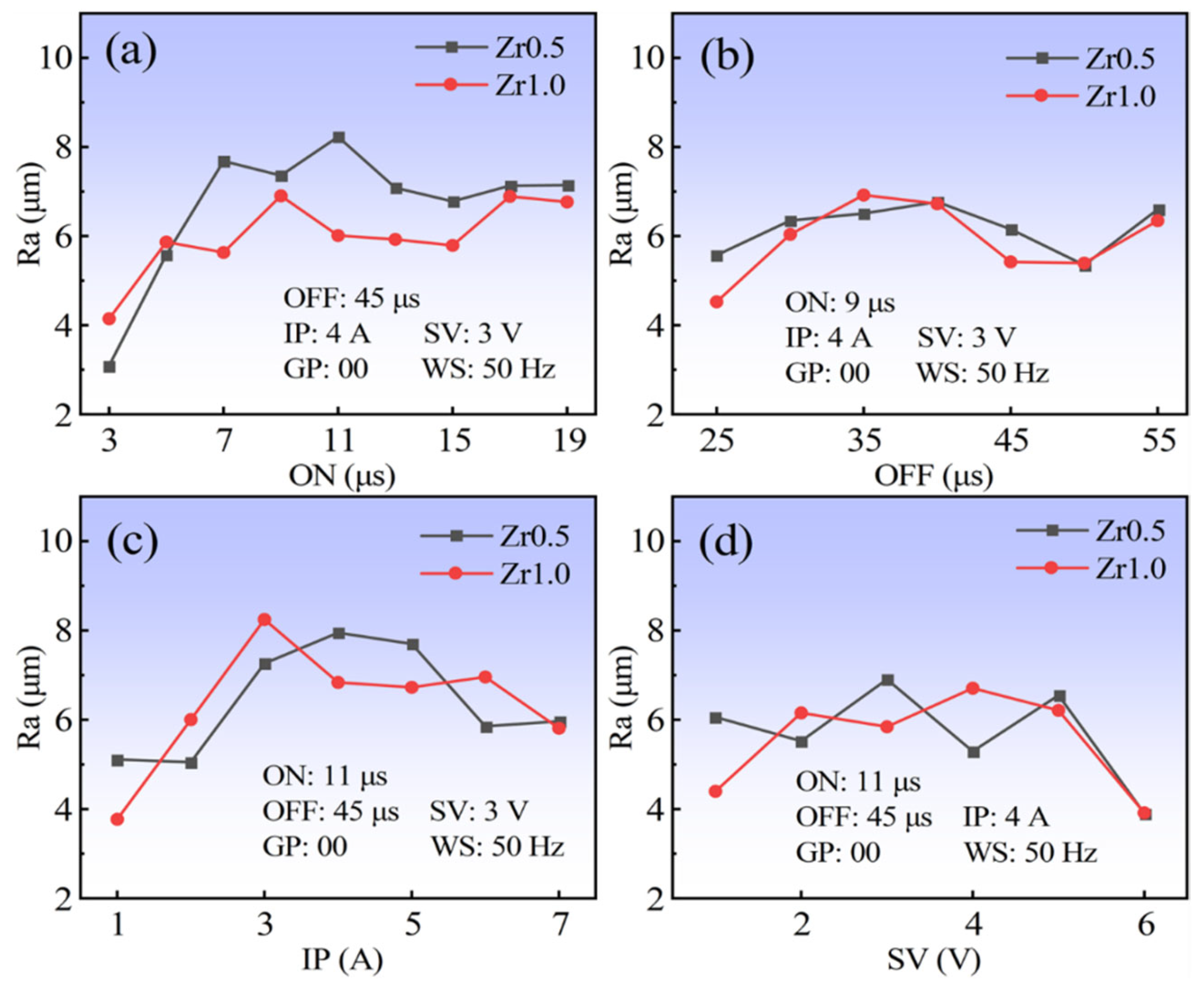

| Materials | W | Nb | Mo | Ta | Zr | C | Hf | Co |
|---|---|---|---|---|---|---|---|---|
| Zr0.5 | 22.22 | 22.22 | 22.22 | 22.22 | 11.12 | - | - | - |
| Zr1.0 | 20 | 20 | 20 | 20 | 20 | - | - | - |
| Zr702 | - | - | - | - | ≥94.7 | - | 4.5 | - |
| Tungsten | ≥99.95 | - | - | - | - | - | - | - |
| YG8 [33] | 43.69 | - | - | - | - | 43.69 | - | 12.62 |
| Materials | Zr0.5 | Zr1.0 | Tungsten | YG8 | Zr702 |
|---|---|---|---|---|---|
| Melting points (K) | 3043 | 2952 | 3695 | 3196 | 2128 |
| Thermal conductivity/W·(m·K)−1 | 26 | 25 | 175 | 70 | 22 |
| Group | Pulse-On Time/μs | Pulse-Off Time/μs | Peak Current/A | Servo Voltage/V | Pulse Type | Barrel Running Frequency (Hz) |
|---|---|---|---|---|---|---|
| 1 | 6 | 35 | 3 | 2 | 00 | 20 |
| 2 | 6 | 45 | 4 | 3 | 01 | 40 |
| 3 | 6 | 55 | 5 | 4 | 02 | 50 |
| 4 | 9 | 35 | 3 | 3 | 01 | 50 |
| 5 | 9 | 45 | 4 | 4 | 02 | 20 |
| 6 | 9 | 55 | 5 | 2 | 00 | 40 |
| 7 | 12 | 35 | 4 | 2 | 02 | 40 |
| 8 | 12 | 45 | 5 | 3 | 00 | 50 |
| 9 | 12 | 55 | 3 | 4 | 01 | 20 |
| 10 | 6 | 35 | 5 | 4 | 01 | 40 |
| 11 | 6 | 45 | 3 | 2 | 02 | 50 |
| 12 | 6 | 55 | 4 | 3 | 00 | 20 |
| 13 | 9 | 35 | 4 | 4 | 00 | 50 |
| 14 | 9 | 45 | 5 | 2 | 01 | 20 |
| 15 | 9 | 55 | 3 | 3 | 02 | 40 |
| 16 | 12 | 35 | 5 | 3 | 02 | 20 |
| 17 | 12 | 45 | 3 | 4 | 00 | 40 |
| 18 | 12 | 55 | 4 | 2 | 01 | 50 |
| Group | Zr0.5 | Zr1.0 | Zr702 | Tungsten | YG8 |
|---|---|---|---|---|---|
| 1 | 7.62 | 9.50 | 12.97 | 2.98 | 9.60 |
| 2 | 3.89 | 4.47 | 5.75 | 1.56 | 3.30 |
| 3 | 2.62 | 3.18 | 4.00 | 1.33 | 1.50 |
| 4 | 4.62 | 5.61 | 8.35 | 2.01 | 5.19 |
| 5 | 3.74 | 4.25 | 4.44 | 1.66 | 3.24 |
| 6 | 11.71 | 14.55 | 19.20 | 5.30 | 12.31 |
| 7 | 6.04 | 7.44 | 12.31 | 2.21 | 6.58 |
| 8 | 14.12 | 18.11 | 25.26 | 6.58 | 16.55 |
| 9 | 2.44 | 3.65 | 4.64 | 1.42 | 1.29 |
| 10 | 5.58 | 5.85 | 7.50 | 2.28 | 4.75 |
| 11 | 2.22 | 3.20 | 4.09 | 0.92 | 2.41 |
| 12 | 6.67 | 7.38 | 10.00 | 3.12 | 5.75 |
| 13 | 12.80 | 14.33 | 21.82 | 5.11 | 13.15 |
| 14 | 5.71 | 7.93 | 10.43 | 2.76 | 6.23 |
| 15 | 2.56 | 3.10 | 4.75 | 1.18 | 2.71 |
| 16 | 7.74 | 8.89 | 13.71 | 3.09 | 8.07 |
| 17 | 8.73 | 10.79 | 17.78 | 3.58 | 11.16 |
| 18 | 4.42 | 5.11 | 8.42 | 2.25 | 3.82 |
| Group | Zr0.5 | Zr1.0 | Zr702 | Tungsten | YG8 |
|---|---|---|---|---|---|
| 1 | 4.55 | 4.84 | 4.07 | 2.28 | 1.47 |
| 2 | 6.00 | 4.86 | 5.14 | 2.86 | 1.32 |
| 3 | 5.35 | 5.16 | 4.72 | 3.01 | 1.45 |
| 4 | 6.21 | 5.59 | 5.76 | 2.30 | 1.58 |
| 5 | 6.45 | 5.38 | 4.95 | 3.03 | 1.44 |
| 6 | 7.13 | 5.11 | 5.23 | 3.45 | 2.79 |
| 7 | 6.21 | 6.17 | 6.94 | 3.05 | 3.65 |
| 8 | 7.50 | 7.27 | 6.30 | 3.59 | 2.69 |
| 9 | 4.41 | 4.18 | 6.20 | 3.22 | 1.53 |
| 10 | 6.33 | 5.46 | 4.34 | 3.11 | 1.38 |
| 11 | 5.11 | 4.77 | 4.78 | 2.52 | 1.60 |
| 12 | 4.70 | 4.64 | 5.26 | 2.43 | 1.36 |
| 13 | 4.54 | 6.14 | 4.83 | 3.30 | 1.75 |
| 14 | 5.69 | 5.87 | 6.59 | 3.26 | 2.41 |
| 15 | 6.08 | 6.38 | 5.21 | 2.30 | 1.79 |
| 16 | 7.03 | 7.92 | 6.77 | 3.80 | 3.33 |
| 17 | 5.55 | 6.90 | 5.68 | 2.67 | 1.88 |
| 18 | 6.12 | 5.48 | 6.75 | 3.35 | 2.05 |
| Alloys | W | Nb | Mo | Ta | Zr |
|---|---|---|---|---|---|
| Zr0.5 (theoretical value) | 22.22 | 22.22 | 22.22 | 22.22 | 11.12 |
| Zr0.5 (group 1) | 25.6 ± 2.1 | 20.0 ± 1.4 | 25.8 ± 4.7 | 25.1 ± 3.0 | 3.5 ± 2.6 |
| Zr0.5 (group 13) | 26.1 ± 1.7 | 19.8 ± 1.2 | 28.1 ± 2.0 | 21.5 ± 0.4 | 4.6 ± 3.8 |
| Zr1.0 (theoretical value) | 20 | 20 | 20 | 20 | 20 |
| Zr1.0 (group 1) | 26.6 ± 1.8 | 16.8 ± 1.4 | 26.8 ± 3.2 | 25.0 ± 3.8 | 5.0 ± 1.4 |
| Zr1.0 (group 13) | 26.5 ± 1.2 | 21.3 ± 2.8 | 27.1 ± 1.2 | 21.7 ± 1.3 | 3.4 ± 1.5 |
Publisher’s Note: MDPI stays neutral with regard to jurisdictional claims in published maps and institutional affiliations. |
© 2022 by the authors. Licensee MDPI, Basel, Switzerland. This article is an open access article distributed under the terms and conditions of the Creative Commons Attribution (CC BY) license (https://creativecommons.org/licenses/by/4.0/).
Share and Cite
Chen, S.; Xu, K.; Chang, W.; Wang, Y.; Wu, Y. On the WEDM of WNbMoTaZrx (x = 0.5, 1) Refractory High Entropy Alloys. Entropy 2022, 24, 1796. https://doi.org/10.3390/e24121796
Chen S, Xu K, Chang W, Wang Y, Wu Y. On the WEDM of WNbMoTaZrx (x = 0.5, 1) Refractory High Entropy Alloys. Entropy. 2022; 24(12):1796. https://doi.org/10.3390/e24121796
Chicago/Turabian StyleChen, Shunhua, Kuang Xu, Weijie Chang, Yong Wang, and Yucheng Wu. 2022. "On the WEDM of WNbMoTaZrx (x = 0.5, 1) Refractory High Entropy Alloys" Entropy 24, no. 12: 1796. https://doi.org/10.3390/e24121796




